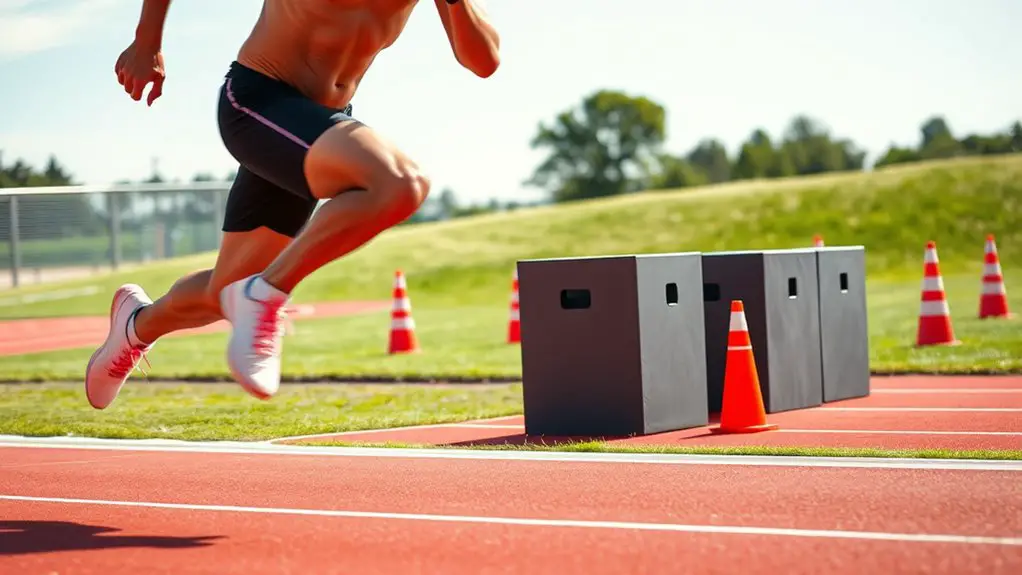To improve your leg power for sprinting and jumping, focus on plyometric exercises like box jumps and squat jumps to build explosiveness. Incorporate strength training with squats, deadlifts, and lunges to strengthen key muscle groups. Don't forget flexibility; dynamic stretches can enhance your range of motion. Consistency is key in your training regime. If you want to learn more about optimizing your leg power and performance, there are additional strategies you can explore.
Understanding Leg Power and Its Importance
Leg power is essential for athletes, especially when it comes to sprinting and jumping. Without strong legs, you can't maximize your speed or height, limiting your performance and potential. It's not just about strength; it's about explosiveness and the ability to generate quick bursts of energy. Think about the freedom you feel when you take off in a sprint or soar through the air. That's your legs working in harmony, giving you the ability to push boundaries. By understanding leg power, you're setting the stage for improvement. It's about building a foundation that allows you to express your athleticism fully. When you harness this power, you're not just running or jumping—you're embracing the freedom to excel and reach new heights.
Key Muscle Groups Involved in Sprinting and Jumping
When it comes to sprinting and jumping, several key muscle groups play a significant role in your performance. Understanding these muscles will help you focus your training effectively.
- Quadriceps: These powerful muscles at the front of your thighs are essential for extending your knees and propelling you forward during sprints and jumps.
- Hamstrings: Located at the back of your thighs, hamstrings work to flex your knees and are important for speed and explosive movements.
- Calves: The muscles in your lower legs, including the gastrocnemius and soleus, are crucial for pushing off the ground and contributing to your overall power.
Plyometric Exercises for Explosive Power
Plyometric exercises are crucial for developing explosive power, which is essential for enhancing your sprinting and jumping abilities. Incorporating moves like box jumps, squat jumps, and burpees can elevate your performance. These explosive movements engage your fast-twitch muscle fibers, allowing you to generate force quickly.
Start with a proper warm-up to prevent injury, then focus on your form to maximize effectiveness. You can vary the intensity and complexity of your workouts, keeping it fresh and exciting. Aim for 2-3 sessions per week, allowing your muscles time to recover. Remember, it's all about pushing your limits while having fun. Embrace the freedom of movement, and you'll notice significant gains in your athletic prowess, revealing your true potential!
Strength Training for Enhanced Leg Power
Building on the explosive power cultivated through plyometric exercises, strength training plays an essential role in enhancing leg power. By incorporating targeted strength workouts, you can build the muscle necessary for both sprinting and jumping. Here are three key exercises to focus on:
- Squats: Engage your quads and glutes, boosting overall leg strength.
- Deadlifts: Strengthen your hamstrings and lower back, promoting balance and power.
- Lunges: Develop unilateral strength, helping to improve agility and coordination.
These exercises not only build muscle but also improve your overall athletic performance. Remember, consistency is key. Push your limits, and you'll release the freedom to sprint faster and jump higher. Embrace the journey, and enjoy the strength you gain!
The Role of Flexibility and Mobility
Flexibility and mobility are essential components of leg power that often get overlooked. When you enhance your range of motion, you release the freedom to sprint and jump with explosive energy. Tight muscles can restrict your performance, but improving flexibility allows for smoother, more powerful movements.
| Benefits | Impact on Performance |
|---|---|
| Increased Range | Better stride length |
| Reduced Injury Risk | Longer training sessions |
| Enhanced Recovery | Quicker return to form |
Incorporating dynamic stretches and mobility exercises into your routine can lead to greater leg power. When you feel free in your movement, you'll discover new heights in your sprinting and jumping abilities. Embrace the journey to flexibility, and watch your potential soar!
Nutrition for Optimizing Performance
While many athletes focus on training regimens to boost leg power, nutrition plays a crucial role in optimizing performance. You can fuel your body effectively to enhance your strength and agility. Here are three key nutritional strategies:
- Carbohydrates: Prioritize complex carbs like whole grains and fruits for sustained energy during intense workouts.
- Proteins: Incorporate lean sources such as chicken, fish, and legumes to support muscle repair and growth.
- Hydration: Stay hydrated with water or electrolyte drinks to maintain peak performance and prevent fatigue.
Incorporating Sprint Drills Into Your Training
Incorporating sprint drills into your training can greatly enhance your leg power and overall athletic performance. By adding sprinting to your routine, you'll develop explosive strength and speed. Start with short sprints, focusing on form and explosive starts. High-knee drills and butt kicks can help improve your leg turnover and flexibility. Include hill sprints to build power; running uphill forces your muscles to work harder. Don't forget to mix in interval training for endurance. Remember, consistency is key, so aim for at least two sprint sessions each week. Listen to your body, and don't hesitate to adjust your drills as needed. Embrace the freedom of movement, and watch your performance soar!
Monitoring Progress and Making Adjustments
To guarantee you're making progress in improving leg power for sprinting and jumping, it's essential to monitor your performance regularly. Keeping track of your workouts helps you stay aware of what works and what doesn't. Here are three ways to effectively monitor your progress:
Regularly monitoring your performance is crucial for enhancing leg power in sprinting and jumping.
- Track Your Times: Record your sprint times and jumping distances weekly. This'll give you concrete data to assess improvements.
- Use a Training Journal: Jot down exercises, sets, and reps. Reflect on how you feel during and after sessions to identify patterns.
- Incorporate Testing: Schedule monthly performance tests, like timed sprints or vertical jumps, to measure your gains.
Frequently Asked Questions
How Often Should I Train for Optimal Leg Power Improvement?
To see ideal leg power improvement, you should train about three to four times a week. Consistency's key, but don't forget to listen to your body and allow for recovery when needed.
What Footwear Is Best for Sprinting and Jumping Performance?
When choosing footwear for sprinting and jumping, opt for lightweight, supportive shoes with good traction. They should fit snugly but comfortably, allowing for freedom of movement while providing the stability you need during explosive efforts.
Can I Improve Leg Power With Bodyweight Exercises Alone?
Yes, you can absolutely improve leg power with bodyweight exercises alone. Squats, lunges, and plyometrics can enhance strength and explosiveness. Just stay consistent, challenge yourself, and enjoy the freedom of training anywhere!
How Long Does It Take to See Results in Leg Power?
You'll likely start noticing improvements in leg power within 4 to 6 weeks of consistent training. Stay committed, mix in varied exercises, and you'll release your body's potential faster than you might expect!
Are There Specific Warm-Up Routines for Sprinting and Jumping?
Strategic stretching and dynamic drills can greatly boost your performance. Start with side shuffles and high knees, then progress to leg swings and butt kicks. These warm-ups'll get your muscles ready for the freedom of sprinting and jumping!




